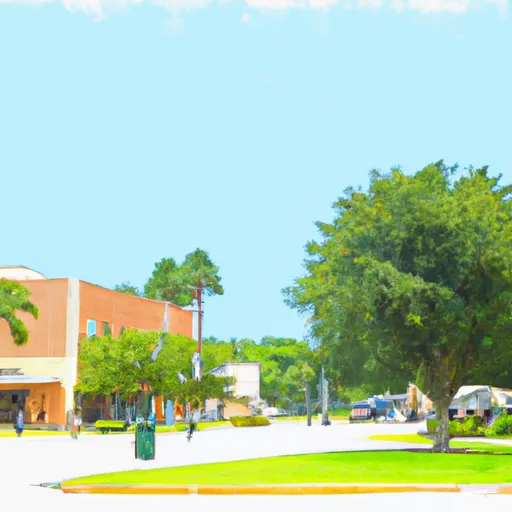-
 Snoflo Premium
Snoflo Premium
Get unlimited access to all our content
With no Ad interruptions! - Start Your Free Trial Login with existing account
Mascotte
Eden Index
Climate
7.0
•
Recreation
4.5
•
Community
2.4
•
Safeguard
5.0/10

Mascotte, Florida is a small city located in Lake County, approximately 30 miles west of Orlando. The climate in Mascotte is classified as humid subtropical, characterized by hot and humid summers, mild winters, and a high level of rainfall throughout the year. The average annual temperature is around 73°F, with summer highs reaching the 90s°F and winter lows dipping into the 50s°F.
Hydrologically, Mascotte is situated near several lakes, including Lake Apopka and Lake Minneola, which offer opportunities for boating, fishing, and water sports. These lakes also contribute to the city's hydrology constituents, as they serve as important water sources for the region.
In terms of outdoor recreation, Mascotte is surrounded by natural beauty, making it a great destination for outdoor enthusiasts. Lake Louisa State Park, located just a short drive away, provides ample opportunities for hiking, biking, camping, and wildlife viewing. The park encompasses a diverse landscape of lakes, rolling hills, and swamps, offering visitors an array of recreational options.
Overall, Mascotte, Florida provides a pleasant climate, access to hydrological features, and various outdoor recreation opportunities, making it an attractive destination for nature lovers and those seeking an active lifestyle.
What is the Eden Index?
The Snoflo Eden Index serves as a comprehensive rating system for regions, evaluating their desirability through a holistic assessment of climate health, outdoor recreation opportunities, and natural disaster risk, acknowledging the profound impact of these factors on livability and well-being.
Climate Health Indicator (CHI): 7.0
Mascotte receives approximately
1302mm of rain per year,
with humidity levels near 88%
and air temperatures averaging around
22°C.
Mascotte has a plant hardyness factor of
9, meaning
plants and agriculture in this region tend to thrive here all year round.
By considering the ideal temperature range, reliable water supplies, clean air, and stable seasonal rain or snowpacks, the Climate Health Indicator (CHI) underscores the significance of a healthy climate as the foundation for quality living.
A healthy climate is paramount for ensuring a high quality of life and livability in a region, fostering both physical well-being and environmental harmony. This can be characterized by ideal temperatures, reliable access to water supplies, clean air, and consistent seasonal rain or snowpacks.
Weather Forecast
Streamflow Conditions
Tampa Bay
Area Rivers
Tampa Bay
Snowpack Depths
Tampa Bay
Reservoir Storage Capacity
Tampa Bay
Groundwater Levels
Recreational Opportunity Index (ROI): 4.5
The Recreational Opportunity Index (ROI) recognizes the value of outdoor recreational options, such as parks, hiking trails, camping sites, and fishing spots, while acknowledging that climate plays a pivotal role in ensuring the comfort and consistency of these experiences.
Access to outdoor recreational opportunities, encompassing activities such as parks, hiking, camping, and fishing, is crucial for overall well-being, and the climate plays a pivotal role in enabling and enhancing these experiences, ensuring that individuals can engage in nature-based activities comfortably and consistently.
Camping Areas
| Campground | Campsites | Reservations | Toilets | Showers | Elevation |
|---|---|---|---|---|---|
| Gores Landing County Park | None | 31 ft | |||
| Salt Springs | 267 | 26 ft | |||
| Big Bass | 34 | 69 ft | |||
| Saddle Creek County Park | None | 111 ft | |||
| Big Scrub | 50 | 145 ft | |||
| Lake Louisa State Park | None | 154 ft | |||
| Santos Rec Area State Park | 24 | 74 ft | |||
| Fore Lake | 100 | 82 ft | |||
| Hopkins Prairie | 21 | 35 ft | |||
| Lake Griffin State Rec Area | None | 85 ft |
Catastrophe Safeguard Index (CSI):
The Catastrophe Safeguard Index (CSI) recognizes that natural disaster risk, encompassing floods, fires, hurricanes, and tornadoes, can drastically affect safety and the overall appeal of an area.
The level of natural disaster risk in a region significantly affects safety and the overall livability, with climate change amplifying these risks by potentially increasing the frequency and intensity of events like floods, fires, hurricanes, and tornadoes, thereby posing substantial challenges to community resilience and well-being.
Community Resilience Indicator (CRI): 2.4
The Community Resilience Indicator (CRI) recognizes that education, healthcare, and socioeconomics are crucial to the well-being of a region. The CRI acknowledges the profound impact of these elements on residents' overall quality of life. By evaluating educational resources, healthcare accessibility, and economic inclusivity, the index captures the essential aspects that contribute to a thriving community, fostering resident satisfaction, equity, and social cohesion.

